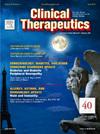抗心律失常药物治疗阵发性或持续性心房颤动的成本-效果:一项经济评估。
IF 3.6
4区 医学
Q2 PHARMACOLOGY & PHARMACY
引用次数: 0
摘要
目的:抗心律失常药物(AAD)治疗是房颤(AF)长期治疗的基础,但在中国的临床和报销决策仍存在不确定性。本研究旨在从卫生系统的角度评估在中国,与胺碘酮和索他洛尔相比,无人机酮治疗阵发性或持续性房颤的成本效益。方法:建立马尔可夫决策模型,比较与房颤复发、充血性心力衰竭、中风、房颤或房颤相关并发症导致死亡相关的三种AAD治疗的终生临床疗效和成本。模型输入来源于雅典娜试验结果、真实世界数据库、已发表文献,并辅以专家意见。成本-效果是通过增量成本-效果比(ICER)来衡量的,增量成本-效果比定义为各组间每质量调整生命年(QALY)获得的增量成本。通过单向敏感性、概率敏感性和情景分析来探讨模型的不确定性。研究结果:本研究使用了一个具有CCC-AF项目患者基线特征的模拟队列。在基本情况下,与胺碘酮和索他洛尔相比,无人机酮预计将获得额外的1.28个QALYs (5.15 vs 3.87)和1.78个QALYs (5.15 vs 3.37),在整个生命周期内的成本更高,分别为6632美元(11,025美元vs 4393美元)和6278美元(11,025美元vs 4748美元),导致ICERs分别为5166美元和3524美元。单向敏感性分析显示,结果对心血管死亡率的相对风险、qaly的贴现率和窦性心律的效用最为敏感。概率敏感性分析表明,在2023年中国人均国内生产总值的1 - 3倍阈值下,无人机酮的成本效益概率在97.0%至99.4%之间,而胺碘酮的成本效益概率在3.0%至3.0%之间。我们的分析表明,在中国,与胺碘酮和索他洛尔相比,对于阵发性或持续性房颤患者,无人机酮是一种具有成本效益的AAD,在长期心律控制方面可改善预期寿命和QALY。本文章由计算机程序翻译,如有差异,请以英文原文为准。
Cost-Effectiveness of Antiarrhythmic Drugs for Treating Paroxysmal or Persistent Atrial Fibrillation in China: An Economic Evaluation
Purpose
Antiarrhythmic drug (AAD) therapies are foundational in the long-term management of atrial fibrillation (AF), yet there remains uncertainty in clinical and reimbursement decisions in China. This study aimed to estimate the cost-effectiveness of dronedarone compare to amiodarone and sotalol for the treatment of paroxysmal or persistent AF in China from the health system perspective.
Methods
A Markov decision model was developed to compare the lifetime clinical efficacy and costs of three AAD therapies associated with AF recurrence, congestive heart failure, strokes, and deaths due to AF or AF related complications. Model inputs were derived from the ATHENA trial results, real-world database, published literature, and supplemented from expert opinion. Cost-effectiveness was measured by the incremental cost-effectiveness ratio (ICER), defined as the incremental cost per quality-adjusted life year (QALY) gained among groups. One-way sensitivity, probabilistic sensitivity, and scenario analyses were performed to explore the uncertainty of the model.
Findings
This study used a simulated cohort with baseline characteristics of patients from the CCC-AF project. In the base case, compared to amiodarone and sotalol, dronedarone was expected to gain additional 1.28 QALYs (5.15 vs 3.87) and 1.78 QALYs (5.15 vs 3.37), with higher costs of $6632 ($11,025 vs $4393) and $6278 ($11,025 vs $4748) over a lifetime horizon, leading to ICERs of $5166 and $3524 per QALY, respectively. One-way sensitivity analysis revealed that the results were most sensitive to the relative risk of cardiovascular mortality, the discount rate of QALYs, and the utility for sinus rhythm. The probabilistic sensitivity analyses indicated that the probability of cost-effectiveness for dronedarone ranged from 97.0% to 99.4% at the threshold of one to three times China’s per capita gross domestic product in 2023, whereas the probability for amiodarone ranged from 3.0% to <1%, and for sotalol was always <1%. Scenario analyses confirmed that the base-case results were sufficiently reliable.
Implications
Our analysis suggests that dronedarone is a cost-effective AAD compared to amiodarone and sotalol for patients with paroxysmal or persistent AF in China, offering improvements in life expectancy and QALY in the long-term rhythm control.
求助全文
通过发布文献求助,成功后即可免费获取论文全文。
去求助
来源期刊

Clinical therapeutics
医学-药学
CiteScore
6.00
自引率
3.10%
发文量
154
审稿时长
9 weeks
期刊介绍:
Clinical Therapeutics provides peer-reviewed, rapid publication of recent developments in drug and other therapies as well as in diagnostics, pharmacoeconomics, health policy, treatment outcomes, and innovations in drug and biologics research. In addition Clinical Therapeutics features updates on specific topics collated by expert Topic Editors. Clinical Therapeutics is read by a large international audience of scientists and clinicians in a variety of research, academic, and clinical practice settings. Articles are indexed by all major biomedical abstracting databases.
 求助内容:
求助内容: 应助结果提醒方式:
应助结果提醒方式:


